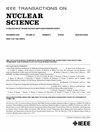Effect of Oxygen-Related Defects on Electrical Properties of Cd0.9Zn0.1Te Semiconductor
IF 1.9
3区 工程技术
Q3 ENGINEERING, ELECTRICAL & ELECTRONIC
引用次数: 0
Abstract
The impurity from raw material in the as-grown crystal is one of the most important factors that hamper the advancement of Cd0.9Zn0.1Te (CZT) detectors. However, the influence of impurity oxygen is rarely reported. In this study, the first principle calculation is carried out to give a prediction about transition levels of oxygen-related defects. Glow discharge mass spectrometry (GDMS) is used to determine the concentration of all the elements. The quantitative analysis of oxygen-related defects is carried out by deep-level transient spectrum (I-DLTS), which can break through the limitations of traditional C-DLTS testing in the field of high-resistance materials. The peaks observed at about 50 and 100 K are related to the level of (VCd–O氧相关缺陷对 Cd0.9Zn0.1Te 半导体电气特性的影响
晶体生长过程中来自原材料的杂质是阻碍 Cd0.9Zn0.1Te(CZT)探测器发展的最重要因素之一。然而,关于杂质氧的影响却鲜有报道。在本研究中,我们进行了第一原理计算,以预测与氧有关的缺陷的过渡水平。采用辉光放电质谱法 (GDMS) 测定所有元素的浓度。氧相关缺陷的定量分析是通过深层瞬态光谱(I-DLTS)进行的,它可以突破传统的 C-DLTS 测试在高阻材料领域的局限性。在约 50 K 和 100 K 处观察到的峰值与 (VCd-O $_{\mathrm {Te}})^{0/-}$ 和 (VCd-O $_{\mathrm {Te}})^{-/2-}$ 缺陷对的水平有关,其能量约为 $E_{\mathrm {v}} +0.079$ eV。+0.079$ eV 和 $E_{\mathrm {V}}+0.173$ eV,陷阱截面分别约为 3.02times 10^{-19}$ 和 1.01times 10^{-19}$ cm2。氧气对 CZT 半导体的 ( $\mu \tau)_{e}$ 的影响是通过阿尔法粒子谱响应测试来评估的,测试方法是将电荷收集效率与施加的偏置电压进行拟合。含氧较多的 CZT 的 ( $\mu \tau)_{e}$ 约为 5.21times 10^{-4}$ cm2/V,含氧较少的 CZT 的 ( $\mu \tau)_{e}$ 约为 2.33times 10^{-3}$ cm2/V。通过激光束诱导电流(LBIC)技术进行的飞行时间(TOF)测试结果表明,两种样品的迁移率都在1000 cm2/V $\cdot $ s1左右,寿命分别为494 ns和2407 ns。由此可以得出结论,与氧有关的缺陷会严重影响电子传输特性。
本文章由计算机程序翻译,如有差异,请以英文原文为准。
求助全文
约1分钟内获得全文
求助全文
来源期刊

IEEE Transactions on Nuclear Science
工程技术-工程:电子与电气
CiteScore
3.70
自引率
27.80%
发文量
314
审稿时长
6.2 months
期刊介绍:
The IEEE Transactions on Nuclear Science is a publication of the IEEE Nuclear and Plasma Sciences Society. It is viewed as the primary source of technical information in many of the areas it covers. As judged by JCR impact factor, TNS consistently ranks in the top five journals in the category of Nuclear Science & Technology. It has one of the higher immediacy indices, indicating that the information it publishes is viewed as timely, and has a relatively long citation half-life, indicating that the published information also is viewed as valuable for a number of years.
The IEEE Transactions on Nuclear Science is published bimonthly. Its scope includes all aspects of the theory and application of nuclear science and engineering. It focuses on instrumentation for the detection and measurement of ionizing radiation; particle accelerators and their controls; nuclear medicine and its application; effects of radiation on materials, components, and systems; reactor instrumentation and controls; and measurement of radiation in space.
 求助内容:
求助内容: 应助结果提醒方式:
应助结果提醒方式:


